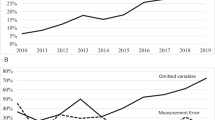Abstract
This paper parametrically obtains estimates of persistence in output using Pandit's (1977, 1982) Data Dependent Systems approach for modelling autoregressive and moving average processes. The estimates are based on over a century of annual data for the rate of change of output in nine industrialized countries. The sensitivity of estimates to various model selection criteria is examined. While persistence in output is found to be sensitive to model selection criteria, the output of all countries including the United States is found to have a substantial degree of persistence if the ARMA models are chosen according to the Schwarz Bayesian Criterion, but excluding the ARMA models whose moving average roots are near the unit root (which involves pile-up phenomenon). Moreover, the parametric estimates of persistence are shown not to have the known upward bias problem commonly associated with parametric estimates of persistence relative to nonparametric estimates.
Similar content being viewed by others
References
Campbell JY, Mankiw NG (1987) Are Output Fluctuations Transitory? Quart J Econ 102:857–880
Campbell JY, Mankiw NG (1988) International Evidence on the Persistence of Economic Fluctuations. National Bureau of Economic Research, Working Paper No 2498, January
Christiano L, Eichenbaum M (1990) Unit Root in Real GNP: Do We Know And Do We Care. Carnegie-Rochester Conference Series on Public Policy 32:7–62
Clark P (1987) The Cyclical Component of U.S. Economic Activity. Quart J Econ 102:797–814
Cochrane JH (1988) How Big is the Random Walk in GNP? J Polit Econ 96:893–920
Cogley T (1990) International Evidence on the Size of the Random Walk in Output. J Polit Econ 98:501–518
De Long JB, Summers LH (1988) How Does Macroeconomic Policy Affects Output? Harvard Institute of Economic Research Paper No 1418, December
Dickey DA, Fuller WA (1979) Distribution of the Estimators for Autoregressive Time Series with a Unit Root. J American Stat Assoc 74:427–431
Diebold FX, Rudebusch GD (1989) Long Memory and Persistence in Aggregate Output. J Monet Econ 24:189–209
Engle RF, Granger CWJ (1987) Co-Integration and Error Correction: Representation, Estimation and Testing. Econometrica 55:251–276
Franz W (Ed) (1990) Hystersis Effects in Economic Models. Physica, Heidelberg
Fuller WA (1976) Introduction to Statistical Time Series. Wiley, New York
Hamilton JD (1989) A New Approach to the Economic Analysis of Non-Stationary Time Series and the Business Cycle. Econometrica 57:357–384
Harvey AC (1985) Trends and Cycles in Macroeconomic Time Series 3:216–227
Harvey AC, Todd PHJ (1983) Forecasting Economic Time Series with Structural and Box-Jerkins Models: A Case Study. J Business and Econ Stat 1:299–307
Jaeger A, Kunst RM (1990) Seasonal Adjustment and Measuring Persistence in Output. J Appl Econ 5:47–58
Kormendi R, Meguire P (1990) A Multicountry Characterization of the Nonstationarity of Aggregate Output. J Money, Credit, Banking 22:77–93
Lo AW, Mackinlay AC (1989) Trends and Random Walks in Macroeconomic Time Series in Finite Samples: A Monte Carlo Investigation. Journal of Econometrics 40:203–238
Long JB Jr, Plosser CI (1983) Real Business Cycles. J Polit Econ 91:36–69
Maddison A (1982) Phases of Capitalist Development. Oxford University Press, New York
Miller KS (1968) Linear Difference Equations. Benjamin, New York
Nelson CR, Plosser CI (1982) Trends and Random Walks in Macroeconomic Time Series: Some Evidence and Implications. J Monetary Econ 10:139–162
Nerlove M (1967) Distributed Lags and Unobserved Components. In: Feller W (Ed) Ten Economic Studies in the Tradition of Irving Fisher. Wiley, New York
Newbold P, Bos T (1990) Introductory Business Forecasting. South-Western Publishing Co, Cincinnati
Ouliaris S, Park JY, Phillips PCB (1989) Testing for a Unit Root in the Presence of a Maintained Trend. In: Raj B (Ed) Advances in Econometrics and Modelling. Kluwer Academic Publishers, Dordrecht, The Netherlands
Pagan AR, Wickens MR (1989) A Survey of Some Recent Econometric Methods. Econ J, pp 962–1025
Pandit SM (1977) Stochastic Linearization by Data Dependent Systems. Transactions ASME, Journal of Dynamic Systems, Measurement and Control 990:221–226
Pandit SM (1982) Data Dependent Systems Approach to Trend and Seasonality. In: Anderson OD (Ed) Time Series Analysis: Theory and Practice I. North Holland Company, Holland
Pandit SM, Shien-Ming Wu (1963) Time Series and System Analysis with Applications. Wiley, New York. Reprinted by Krieger (1990)
Perron P (1989) The Great Crash, The Oil Price Shock, and the Unit-Root Hypothesis. Econometrica 57:1361–1401
Perron P (1991) Further Evidence on Breaking Trend Functions in Macroeconomic Variables. Unpublished Manuscript. Princeton University, Dept. of Economics
Quah D (1988) The Relative Importance of Permanent and Transitory Components: Identification and some Theoretical Bounds. Working Paper 498. Massachusetts Institute of Technology
Raj B (1991) International Evidence on Persistence in Output in the Presence of an Episodic Change, mimeographed, paper presented at the American Statistical Association Meetings, Atlanta, Georgia, August 1991, the Canadian Econometric Study Group, University of Laval, Quebec City, September, 1991 and the Indian Econometric Society Meetings, Bagdogra. Univ of West Bengal, India, Oct 1991 (Forthcoming in the Journal of Applied Econometrics)
Rao CR (1973) Linear Statistical Inference and Its Applications. Wiley, New York
Rose AK (1986) Four Paradoxes in GNP. Economics Letters 22:137–141
Said SE, Dickey DA (1984) Testing for Unit Roots in Autoregressive-Moving Average Models of Unknown Order. Biometrika 71:599–607
Schwarz G (1978) Estimating the Dimension of a Model. Ann Stat 60:461–464
Schwert GW (1987) Effects of Model Misspecification on Tests for Unit Roots in Macroeconomic Data. J Monetary Econ 19:73–103
Schwert GW (1989) Tests for Unit Roots: A Monte Carlo Investigation. J Business Econ Stat 3:147–159
Stock JH, Watson MW (1988) Variable Trends in Economic Time Series. J Econ Perspectives 2(3):147–174
Watson MW (1986) Univariate Detrending Methods with Stochastic Trends. J Monetary Economics 18:49–75
West KD (1988) On the Interpretation of Near Random-Walk Behavior in GNP. Amer Econ Rev 78:202–209
Zivot E, Andrews DWK (1991) Further Evidence on the Great Crash, the Oil Price Shock, and the Unit Root Hypothesis. Cowes Discussion Paper, p 994
Author information
Authors and Affiliations
Rights and permissions
About this article
Cite this article
Raj, B. An international study of persistence in output: Parametric estimates using the data dependent systems approach. Empirical Economics 18, 173–195 (1993). https://doi.org/10.1007/BF01238885
Received:
Revised:
Issue Date:
DOI: https://doi.org/10.1007/BF01238885




